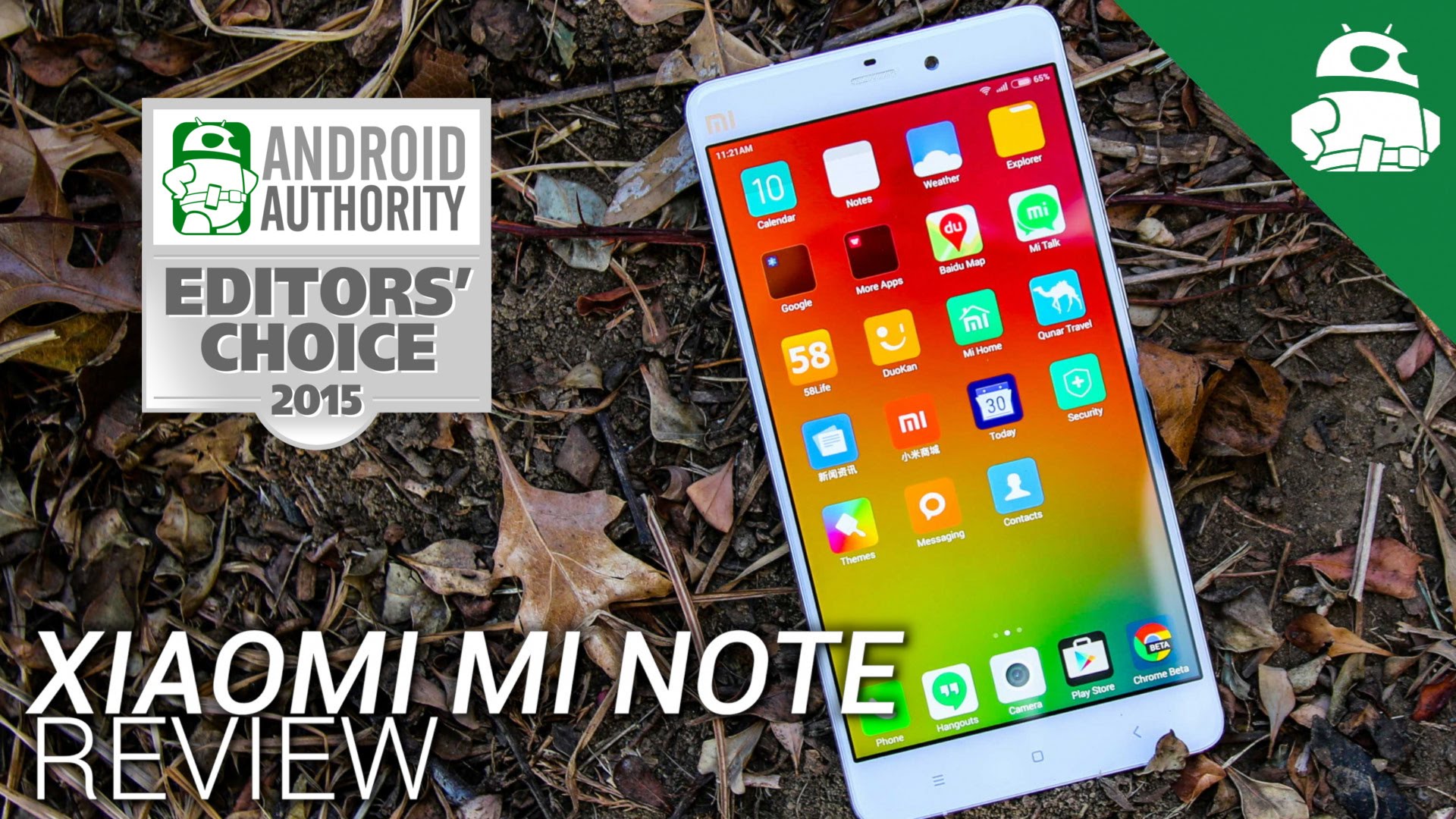Affiliate links on Android Authority may earn us a commission. Learn more.
Xiaomi Mi Note Review


During the press event held by Xiaomi in February to introduce their accessory store for the US market, the company handed out their 2015 flagship smartphone, the Mi Note, to all the attendees. While this device is not marked for an official US release, was this move a way for Xiaomi to show that they do have what it takes to compete in the over-crowded and highly-competitive smartphone market in the US? We find out, as we take a closer look at this phone in this comprehensive Xiaomi Mi Note review!
As the Note moniker suggests, this device falls squarely in the phablet category, and Xiaomi has certainly gone all out when it comes to design and build quality. The Mi Note is a gorgeous device, with 2.5D glass up front with its subtle curves along the edges, and the back featuring what Xiaomi calls 3D glass, with far more pronounced curves along its sides. All of this held together by a metal frame with chamfered edges, allowing for a solid device that feels great in the hand.
Despite its rather large size, one-handed usability isn’t as uncomfortable as you might expect, courtesy of its thin bezels along the sides of the display, along with the fact that the device is impressively thin, with a thickness of just 7 mm. Some hand gymnastics are required to get across to every part of the display of course, but everything is fairly manageable for the most part.
The back is made of glass, which does lead to it getting smudgy and attracting a lot of fingerprints, but isn’t very noticeable on this white version of the smartphone unless you are looking specifically for them. The same may not be the case for the black version though, which is something to watch out for when making the choice between the two.
Looking around the device, the power button and volume rocker are placed on the right side, positioned to make them easy to reach, and are very easy to press, with a nice tactile feedback. The SIM card slot is on the right, the headphone jack is up top, with the microUSB port and single speaker placed at the bottom. Capacitive menu, home, and back keys are found up front, along with a multi-colored LED notification light, earpiece, and front-facing camera at their usual locations above the display.
The Xiaomi Mi Note features a large 5.7-inch IPS LCD display, with a 1080p resolution resulting in a pixel density of 386 ppi. Color saturation, viewing angles, brightness, and outdoor visibility are all very good, and the sizable display screen real estate makes for a very pleasurable experience when it comes to browsing the web, watching videos, or playing games.
The color calibration of the display can also be adjusted in the settings, allowing you to configure the level of contrast and warmth of the display. That said, the default settings itself do look good, and you may not feel the need to make any significant adjustments. Features like “glove mode” are also available to increase touchscreen sensitivity, and there is also a “reading mode,” that reduces glare and makes the screen a lot easier on the eyes. It’s similar to how the flux application works for windows and mac, and you can even select which applications will trigger this feature.
Under the hood, the Xiaomi Mi Note packs a quad-core Qualcomm Snapdragon 801 processor, clocked at 2.5 GHz, and backed by the Adreno 330 GPU and 3 GB of RAM. Apart from the amount of RAM, this processing package may seem a little dated given the advances in the last year, but it is still more than capable of easily handling intensive tasks.
General tasks like swiping, scrolling, opening, closing, and switching between applications, and navigating around the user interface is as expected, smooth, and the device can handle gaming comfortably without any issues. It has to be mentioned that the device did get uncomfortably warm though after playing games for a while, but there was no associated decrease in performance though.
Another noteworthy fact is that the device used for this review is a pre-production unit, and as such, there were some application crashes and random freezing that occurred because of the beta software on-board. Save for these instances, the performance is smooth and snappy, and these bugs will most likely be taken care in the final release units.
Coming to the rest of the hardware, the Mi Note packs the usual suite of sensors and connectivity options, including 4G LTE, but unfortunately with no support for US LTE bands. 16 GB or 64 GB of built-in storage is available, and without the availability of any expandable storage via microSD card, the latter of the two options is likely what most consumers will prefer.
The bottom mounted speaker does sound good, and the volume does get fairly loud. That said, its placement at the bottom results in side firing audio when using the device in landscape orientation, while also being fairly easy to cover up the speaker and muffle the sound with your palm when using it in this alignment.
When it comes to the battery, you get a respectable 3,000 mAh unit, but is just about average given the capabilities of the slew of other smartphones in this size category. Regardless, the battery life has been very solid during my testing. With usage consisting of mostly texting, web browsing, and checking social media, along with some light gaming and video watching on Youtube, I managed to squeeze out up to a day and half of battery life, with a little more than 5 hours of screen-on time. On heavy usage days that involved lots of gaming and taking photos, the screen-on time dropped to 4 hours, but still lasted the entire day.
Another contributing factor to this impressive battery life is the standby time, with the device losing just 1 to 2 percent of battery life overnight. If you are looking for more, battery saving profiles are available in the settings that disable Wi-Fi, data, and other network functions to help you extend battery life even further, and these profiles can also be set to come on automatically when battery life hits a specified percentage.
The Xiaomi Mi Note features a 13 MP rear camera, that comes with optical image stabilization and a dual tone LED flash, both features that are is not all too uncommon in smartphones nowadays. The camera UI is fairly simple to navigate and use, with a large white shutter button, and packing a decent number of features and modes without things getting too overwhelming.
Swiping upwards or to the right will bring up several different modes like manual, panorama, refocus, and a few others. Swiping downwards or to the left will bring up a variety of live filters, for those who want to have a little bit more fun with their picture taking. The exposure can also be dialed in manually by simply turning the digital ring on the screen, which is definitely a nice touch, and feels extremely intuitive. The refocus mode allows you to refocus a photo after the fact, which isn’t a groundbreaking feature, but does work pretty well, as long as you follow the guidelines of having a clear subject of focus and a clear background.
The overall picture quality was actually pretty good. The shutter speed is fast, and photos come out looking sharp with a great amount of color in both indoor and outdoor situations. The HDR mode also works really well on this camera, bringing back some detail while adding some extra warmth and color into the image. In low light, an increase in noise levels is to be expected, but the OIS and ISO limit of 3200 certainly helps the camera pull in as much detail as possible. While the images are usable, there is a pretty substantial decrease in sharpness and detail, but for the most part, this camera has been a great performer.
The front-facing camera is a 4 MP sensor, and for all you selfie lovers out there, it features a beautify mode that attempts to enhance your appearance by identifying your age and gender. It works well as far as the images quality goes, but somehow never managed to guess my age correctly.
In software, the Mi Note is currently running Android 4.4 Kitkat, with Xiaomi’s MIUI on top. As is the case with many other chinese OEMs and their custom operating systems, the MIUI interface does away with the app drawer, in favor of an all home screen experience, which means that you will be dependent on using folders as the only way to stay organized.
The icons are square and colorful, and so are the pre-loaded wallpapers, that actually look great on this display, without being gaudy or overbearing. In this review unit, there were a lot of Chinese applications pre-installed, and the Google Play Store isn’t available by default, but it was very quick and easy to install it and then download all the applications that I needed.
The MIUI interface introduces some really nice features, like Hi-Fi audio for improved audio quality when using headphones, and a robust theme engine that lets you alter the look and feel of the OS from the icons, wallpapers, lockscreen, and even the default applications. A one-handed mode is also available, that can be activated by simply swiping from the home button outward in either direction, to shrink the screen down from anywhere between 4.5-inches to 3.5-inches. Overall, the MIUI interface does bring a lot of nice additions to the core Android experience, even if its different nature may take some getting used to, and certainly isn’t for everybody.
| Display | 5.7-inch IPS LCD Full HD, 386 ppi |
|---|---|
Processor | 2.5 GHz quad-core Qualcomm Snapdragon 801 Adreno 330 GPU |
RAM | 3 GB |
Storage | 16 GB/64 GB not expandable |
Camera | 13 MP rear camera with OIS and dual LED flash 4 MP front-facing camera |
Connectivity | Wi-Fi 802.11 a/b/g/n/ac, dual-band, WiFi Direct, hotspot Bluetooth 4.1, GPS + GLONASS microUSB 2.0 |
Networks | 3G / 4G LTE (only in select markets) |
Software | Android 4.4 Kitkat |
Battery | 3,000 mAh |
Dimensions | 155.1 x 77.6 x 7 mm 161 grams |
In China, the Xiaomi Mi Note is priced at the equivalent of around $370. This device hasn’t officially been released in the US, but can be picked up via eBay, which will set you back a comparatively steep $500 though.
So there you have it – a closer look at the Xiaomi Mi Note! To answer the question asked in the introduction, this device certainly proves that Xiaomi is more than capable of competing in the over crowded US smartphone market, and it is actually quite unfortunate that it won’t be officially available there. All in all, the Xiaomi Mi Note is one very solid device from hardware to software, and is one of the most enjoyable devices that I have had the pleasure of using from a Chinese OEM in quite some time, which is what makes the Xiaomi Mi Note worthy of our Editor’s Choice Award.
[related_videos title=”Other awesome videos! ” align=”center” videosnum=”5″]